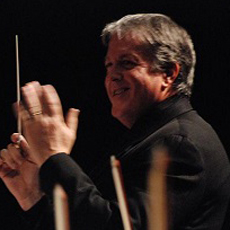Walt Disney Productions (1929-1938), Walt Disney Home Entertainment (December 19, 2006), 2 disc set, 316 mins plus supplements, 1.33:1 original full frame ratio, Dolby Digital 2.0 Mono, Rated G, Retail: $32.99
Storyboard:
The second and final volume of Silly Symphonies released in Disney’s popular Walt Disney Treasures line includes over 5 hours of classic Disney shorts.

The Sweatbox Review:
When Walt Disney first began experimenting with sound for a new series of cartoons, the use of music was already in full swing. Even with his first sound cartoon, Steamboat Willie, music already played an important part of the equation with Mickey playing with different animals as if they were musical instruments. Disney’s musical director, Carl Stalling, would be the first to suggest that music be the driving force of a series of cartoon shorts that would later become the Silly Symphonies. Beginning with The Skeleton Dance, the Silly Symphonies would blend the great animation talent found at Disney with popular music from the time to drive the action in the cartoons.
The relationship between music and animation started at Disney, and it is only fitting that the use of music is still prevalent in Disney features in the modern age. Disney defined the use of music in cartoon shorts in his very first Mickey Mouse cartoons, perfected that use in the Silly Symphonies cartoons, and later translated that same music to feature films beginning with Snow White and the Seven Dwarfs in 1937. Some would say that the culmination of the use of music came even later with the classic 1940 film, Fantasia. This use would continue with the south of the border and musical comedies of the 40s, and would later resurge in the Disney Renaissance with classic films such as Cinderella and The Jungle Book where musical segments are still the most memorable parts of the films. Disney would later redefine music in film with their first modern animated musicals such as The Little Mermaid and Aladdin. Even Fantasia would be revisited in 1999 with the incredible Fantasia 2000 where new classical themes and elements were explored and put to animation.

When the first wave of Walt Disney Treasures hit the streets in 2001, Silly Symphonies quickly sold out along with the popular Mickey Mouse in Living Color set. With classic and memorable shorts such as The Ugly Duckling and The Three Little Pigs, it was clear that it was meant to be a definitive, if not complete, Silly Symphonies set. When it was announced that there would be a second wave, collectors and animation fans around the world began calling for a second Silly Symphonies set that would include some popular and beloved shorts not included in the first wave such as Little Hiawatha, El Terrible Torreador, Santa’s Workshop, Merbabies, and The Night Before Christmas. It seems that since the second wave was announced, there was always a rumor circulating around the net that a 2nd release would include the rest of the Silly Symphonies. Some of the previously unreleased shorts even began to pop up in other Disney DVD compilations such as their recent Timeless Tales line, which included The Pied Piper (Vol. 1) and Little Hiawatha (Vol 3). Part of the problem with releasing a second Silly Symphonies set was with some of the cultural and racial stereotypes found in some of the shorts. However, since the Walt Disney on the Front Lines release, Treasures host Leonard Maltin has done a great job at placing these historic cartoons into their proper context. A second volume of Silly Symphonies shorts was finally announced last summer, much to the delight of fans.
In his second volume, the remaining Silly Symphonies are divided into two discs with the first disc containing shorts between 1929 and 1932, and the second one holding shorts between 1933 and 1938. The separation can also been seen as pre and post Technicolor as all those found on the first disc are black and white and those on the second disc are in color. Unlike previous Treasures releases, these are not really chronologically linked to the previous volume, which included mostly color cartoons, leaving black and white ones to this release. While it is true that the color cartoons are more stimulating, not only with visuals but also with storylines, it is great to see some of the early black and white Silly Symphonies because it allows us to see an evolution of the series. The Silly Symphonies, and this set, can be divided into three separate phases.

The first phase of the Silly Symphonies cartoon involved animals or inanimate objects dancing in nature to the tune of popular or classical songs. While showing animals and plants dancing to the tune of music was a novelty for filmgoers when the series debuted in 1929, this formula would quickly grow old. Still, it is interesting to see how the animators used the shorts as a way to experiment with new ideas in music, special effects, character animation, and stories. I would include all but one of the shorts between 1929 and 1930 in this group. These shorts include: Hell’s Bells (1929), The Merry Dwarfs (1929), Springtime (1929), Arctic Antics (1930), Autumn (1930), Frolicking Fish (1930), Monkey Melodies (1930), Night (1930), Playful Pan (1930), Summer (1930), Winter (1930), Cannibal Capers (1930), Midnight In A Toy Shop (1930), and The Clock Store (1931).
The only short I do not include in this category was the second Silly Symphony produced called El Terrible Torreador (1929). After Skeleton Dance, Disney had the idea of using popular operas as the stories for the Silly Symphonies. In El Terrible Torreador, the story follows a young woman named Carmencita and a toreador who battles a bull for her love. The story is loosely based on the storyline from the popular opera Carmen, and even uses some of the music. After a series of problems that started with Disney’s wish to record the sound in Los Angeles, the master record was useless and the original negatives were lost in the mail. They abandoned the idea to do operas after this one, even though it was a popular cartoon when it opened opposite the Frank Capra movie, Flight in September of 1929.

Some of the most notable cartoons from this first phase include Springtime, Night, Monkey Melodies, Winter, Midnight In A Toy Shop, and The Clock Store. Disney released each of the four seasons with their own short, but their first one, Springtime, typified the animation style used in this first phase. In a scene reminiscent of the later Technicolor short Flowers and Trees, animals and flowers are dancing to a tune. The plot doesn’t really exist, but the animals and plants dancing in synch was a way for Disney to show off their animation techniques. In one scene, a spider jumps towards the screen, which is a trademark Ub Iwerk’s animation technique frequently used in many of these first cartoons. These first cartoons became a testing ground for special effects and music as well as animation. In Night, the animators experience with water effects (also seen in Frolicking Fish), and glowing effects. In Monkey Melodies, Disney departs from the classical themes and uses contemporary tunes in their sound track. Most of the shorts in this first phase were nature-oriented, but there was a transition to the more urban setting when we get to The Clock Store and Midnight In A Toy Shop. This coincided with the first cartoons directed by Wilfred Jackson and scored by Frank Churchill.
While the first phase of the Silly Symphonies basically consisted of cartoons featuring dancing animals eating one another, this idea developed into the second phase. The animals randomly eating one another gave way to cartoons where a main character would have to overcome some obstacle to survive or thrive. We can see these in the cartoons between 1931 and 1932. In The Bears and The Bees it’s young versus old bears, in The Bird Store it’s cat versus bird, and in The Spider And The Fly, it’s spider versus flies. The music continues to play a role, but now it’s more chase and suspense music as opposed to music the animals can dance to. It is interesting to see how Disney revisits some themes that he had already done in the past. The Fox Hunt is similar to a 1928 Oswald cartoon called The Fox Chase, and this same idea of a foxhunt is revisited in 1938’s The Fox Hunt with Donald and Goofy. In this short, we also begin to get a glimpse of the dog that will later become Pluto.

The end of the first disc coincides with the beginning of a new phase in the Silly Symphonies. Animators had already begun working with personality animation and stronger plot points for their shorts. Beginning with Bugs In Love in 1932 and going all the way through 1938, Disney continued to develop their characters and followed them through the entire cartoon. Now, the creatures are no longer dancing (something phased out in 1931), but they are also given more to do. It is no longer a simple David versus Goliath theme, although there is a transitional phase. In Bugs In Love, probably the first to work out a more complex storyline, two bugs are in love, but their romance is cut short when a crow tries to eat them. It’s a similar theme to the one used in The Spider And The Fly, but here it is more complex and we seem to get to know the main characters better. We connect with them and actually care about the characters. Bugs In Love was based on the Disney comic released earlier that year that featured Bucky Bug and June Bug in the main roles. The two became a fixture of Disney comics and still have stories today.
The natural transition between discs one and two is the use of color. Beginning with Flowers And Trees (found on the first Silly Symphonies release), Disney began to use the 3-strip Technicolor process in their cartoons. The technique would continue to be perfected over the next few years, and we can see this by comparing Flowers And Trees to King Neptune, the 2nd Technicolor cartoon, which is included in this release. There is no particular theme that holds these shorts together, but many fables and spoofs on known fables were turned into cartoons. We get cartoons based on popular nursery rhymes (Old King Cole, Three Blind Mouseketeers, and Mother Goose Goes Hollywood), Santa Claus (The Night Before Christmas and Santa’s Workshop), The Pied Piper, and even mythological characters such as Persephone (The Goddess of Spring) and Neptune (King Neptune). The cartoons on the second disc are from the years 1933 to 1938, many already part of Disney’s new distribution deal with United Artists, which made the cartoons even more popular.
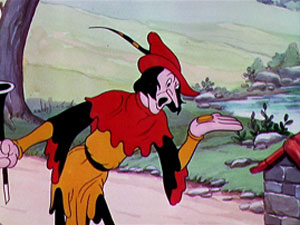
Some of my favorite shorts on this set are on this second disc, and with these shorts we are able to see a development in Disney’s storytelling abilities as well as their improved use of special effects and music. In terms of special effects, we already see fire, water, and light effects perfected in cartoons such as Merbabies and Moth And The Flame. As far as the music, Disney began using in-house talent to score and write lyrics for his cartoons. The music is also improved and now flows through the story as an accompaniment as opposed to directing the action. The music written by Leigh Harline features prominently on several of these shorts including The Pied Piper, The Goddess of Spring, The Night Before Christmas, predating his Academy Award-winning music in Snow White And The Seven Dwarfs and Pinocchio. In The Pied Piper, we get to hear an elaborate interplay between solo singers (the Piper and the Mayor) and a chorus (the townspeople). In The Goddess of Spring, music is used to differentiate between the upper world and Hades, with classical music playing on Earth and jazz playing in Hades (a similar theme would be used in Music Land).
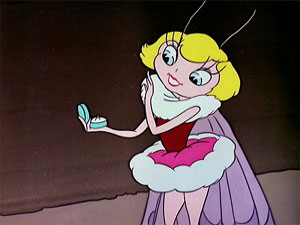
Other great shorts include Cock O’ The Walk, a short featuring beautiful animation of dancing fowl in line with the WB musicals of the time, Moth And The Flame, where a beautiful moth is attacked by a dangerous flame (and where rippling scales suggest the fluttering of her wings), and The Night Before Christmas, probably one of Disney’s best Christmas cartoons. However, my absolute favorite cartoon is Little Hiawatha, about a young “fearless warrior” that is trying to act brave and hunt a rabbit while constantly loosing his pants (the short would be spoofed in the Merry Melodies cartoon Hiawatha’s Rabbit Hunt featuring Bugs Bunny). The short works because of great character animation, a clever poem read by a narrator, and the subtle music by Albert Hay Malotte (who also does great work in Cock O’ The Walk, Broken Toys, Three Blind Mouseketeers, and Moth And The Flame). Rounding out this group of great shorts is Merbabies, the only Silly Symphony animated outside the Disney studios. In this case, Disney farmed out the cartoon to Harman and Ising after they lost their contract with MGM. Disney was busy working on Snow White and agreed to give them work in exchange for their ink and paint department.

The two discs include a “From the Vault” section highlighting cartoons with questionable cultural and racial references. Leonard Maltin introduces this section (his introduction cannot be skipped) putting the cartoons in the right frame of reference. In these shorts, we basically get many references to Topsy from Uncle Tom’s Cabin, characters channeling Al Jolson and yelling “mammy!”, caricatures of famous black performers, and caricatures of black maids, Chinese dolls, and Jewish immigrants. On the first disc we have El Terrible Torreador (in the vault more because it is rare), The Merry Dwarfs (heavy drinking), Cannibal Capers (depiction of African natives and a Jewish caricature), and Midnight In A Toy Shop (Topsy doll yelling “mammy!”). Two versions of Cannibal Capers are included with Leonard Maltin introducing the restored, uncut version not seen since the original release. The second disc has a more diverse group of cartoons including Santa’s Workshop (racial stereotypes on some toys), King Neptune (gratuitous nudity on mermaids and heavy drinking), Broken Toys (controversial depiction of Stepin Fetchit – a famous black comedian from the 1930s), Three Orphan Kittens and More Kittens (black mammy maid speaking Ebonics later seen in Figaro shorts and more mammy jokes), Mother Goose Goes Hollywood (blackface gag, another Stepin Fetchit caricature). My favorite cartoons in this vault section are the ones with Hollywood references. Many famous movie stars from the era are caricatured including Zasu Pitts, Ned Sparks, the Marx Brothers, WC Fields, Greta Garbo, Cat Calloway, and Katharine Hepburn.
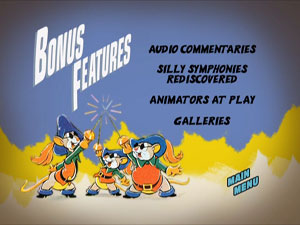
Is This Thing Loaded?
Maltin introduces the special features on the second disc and he talks about the different special features and collaborators featured in the audio commentaries. In fact, the commentaries are the highlight of the set and they are packed with insightful and informative observations on almost two dozen Silly Symphonies. There are audio commentaries for Springtime (Daniel Goldmark), Night (Ross Care), Monkey Melodies (David Gerstein), Winter (Daniel Goldmark), The Clock Store (Ross Care), The Spider And The Fly (Leonard Maltin and Daniel Goldmark), The Fox Hunt (JB Kaufman) , Bugs In Love (two commentaries – David Gerstein and another by Ross Care), El Terrible Torreador (JB Kaufman), Midnight In A Toy Shop (Jerry Beck), Cannibal Capers (David Gerstein and Leonard Maltin), Old King Cole (Richard Sherman), The Pied Piper (Ross Care), The Goddess Of Spring (Daniel Goldmark), Cock ‘O The Walk (JB Kaufman), Moth And The Flame (Ross Care), Merbabies (JB Kaufman), Santa’s Workshop (JB Kaufman and Leonard Maltin), King Neptune (Jerry Beck), Broken Toys (Jerry Beck), Three Orphan Kittens (Richard Sherman), Mother Goose Goes Hollywood (Leonard Maltin). Each commentator has his own area of expertise. Maltin is a film historian, Ross Care provides insightful commentaries on the music, Daniel Goldmark talks about music in cartoons, JB Kaufman talks about the history of the production, Jerry Beck puts the cartoons in a historical perspective in animation, David Gerstein talks about links to Disney comics and other archival material, and finally Richard Sherman basically just praises the cartoons while providing some commentaries on story structure and music. All of the commentaries, except for Richard Sherman’s, are highly recommended. Sherman’s commentaries are fluff pieces and he does not add much to the viewing experience.

Two featurettes are included in the second disc. The first, and most extensive is “Silly Symphonies Rediscovered” (14:31). It features interviews with animation historians and Silly Symphonies experts talking about the Silly Symphonies and their evolution over the years from The Skeleton Dance to The Ugly Duckling. Highlights include information about Carl Stalling, Frank Churchill, and Leigh Harline, the main musical contributors in the series. Much is also said about innovations such as high fidelity RCA recordings as well as 3 Strip Technicolor. For those who do not have the patience to sit through all of the commentary tracks, they are nicely condensed here in these interviews that cover much of the same ground, although not as in-depth as the commentaries. Disney fans will enjoy it, but more dedicated fans should really sit through the commentaries to learn the facts in more detail.

The second featurette on the second disc is called “Animators At Play” (6:11) where Leonard Maltin narrates a real lunchtime softball game with Disney animators and staff. The video, still intact with sound, was shot sometime in the winter of 1930-31, although the reason for the recording is unknown. Maltin does a good job of pointing out different staff members and shares information about what was going on at the studio at the time it was shot. It is a fascinating glimpse into an era when Disney was still a small company struggling to survive, before things got big and corporate.
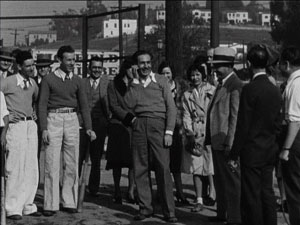
The only other special features on the second disc are the galleries. There are three different galleries. “The Art Of The Silly Symphonies” feature 85 stills from the different cartoons shorts – from posters to background and animation sketches. “Silly Symphonies In Print” features 30 stills from Silly Symphonies in book form, including some pages from the book Walt Disney’s Mickey And The Gang. Finally, “Sunday Funnies And Comic Books” feature 66 stills from comic books and funnies from as early as the 30’s up to modern day comics, including one from Brazil where the comics are still widely read.
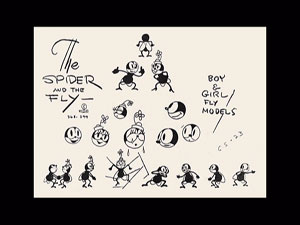
Case Study:
The packaging for this set is similar to previous releases. The only difference from early releases is that there is no band around the outside of the tin, and the back cover on the tin is made of cardboard and can be detached. The case is back to its original black color. I was surprised by the low print run of 65,000 tins referenced in the certificate of authenticity. I would have thought that this set in particular would sell well since cartoons have generally sold-out faster than other Treasure sets. Aside from the certificate of authenticity, there is also a lithograph for the release poster for Summer.
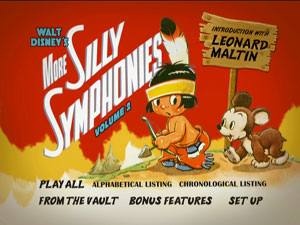
Ink And Paint:
The video quality in these cartoons varies greatly with earlier cartoons notably suffering from old age. However, considering that some of these cartoons are almost 80 years old, I am glad that we are able to see them at all. The earlier cartoons suffer from visible grain that can still be seen on the print, with later prints like Moth And The Flame featuring a more clean transfer, although they are not perfect. Basically, everything is as we expected. I think what is great about these releases is that the shorts are so entertaining that I did not even notice the quality of the prints. I should note that some of the original titles have been replaced, and one (The Cat’s Out) has been restored to its original title (it had been changed to The Cat’s Nightmare). The Technicolor cartoons are the true highlights and it is easy to see why Disney was years ahead of his competition in terms of experimenting with color. The cartoons are vibrant and I can only imagine what moviegoers felt when they first saw colorful dancing animals on the silver screen. The shorts can be found chronologically or alphabetically, and the Play All feature plays them chronologically. Note that the cartoons from the Vault section must be played separately and we cannot skip over Maltin’s introduction/warning (although we can fast-forward).
Scratch Tracks:
Listening to the music for the Silly Symphonies is like getting a lesson in movie music and sound techniques. Disney was an innovator in sound and he began using the RCA high fidelity records long before they became popular. I loved listening to the different styles that Carl Stalling, Leigh Harline, Frank Churchill and others brought to their perspective cartoons. It’s interesting that many of these songs are still popular or at least known today so music fans will have a fun time trying to recognize the music. I recommend turning on the subtitle feature that lets you know which song is playing. Classical music owes much to some of the shorts for keeping them popular and in the mainstream years after their original release.

Final Cut:
I was sad to hear that the Walt Disney Treasures line is probably coming to an end. Much will be said about some of the incomplete sets, but I for one am at least glad that we have gotten closure for the Silly Symphonies series. The collection has come full circle. Silly Symphonies was the first Walt Disney Treasure that I purchased and it is only fitting that it is also closing out the series. The Silly Symphonies will forever sit in animation history as one of the most influential cartoon series. The way that Disney used the cartoons to experiment with new sound and animation techniques was an inspiration to the animators of their era and even today. The blending of animation and music continues to inspire us all and I for one am glad that we can finally enjoy this complete series on DVD.
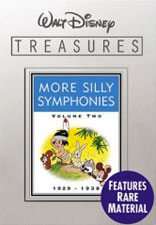 | ||
 |







